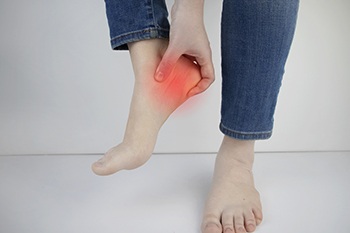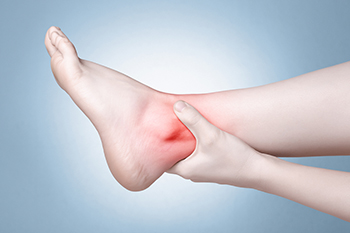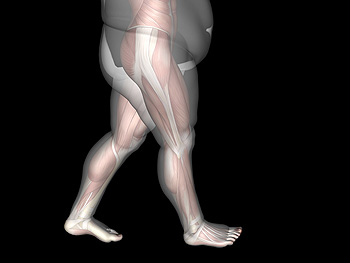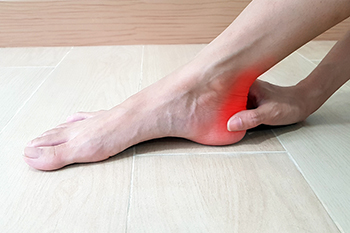Items filtered by date: July 2022
How Did I Develop Plantar Fasciitis?

Plantar fasciitis is a foot condition that affects the heel and the arch. It is often accompanied by severe pain and discomfort, and it can be difficult to walk. It occurs as a result of inflammation of the plantar fascia and can happen from placing excess weight on the plantar fascia. This is the band of tissue that connects the heel to the toes and runs along the sole of the foot. Some of the symptoms that are associated with plantar fasciitis can include severe heel pain that may worsen after arising in the morning, or it may be noticed after sitting or standing for long periods. There may also be existing conditions that can lead to plantar fasciitis. These can include pregnancy, obesity, having tight calf muscles, or possibly having flat feet or high arches. Relief can come from resting the affected foot as often as possible and wearing shoes that have adequate support and cushioning. If you feel heel pain for any reason, please confer with a chiropodist who can accurately diagnose this condition and offer the correct treatment options.
Plantar fasciitis can be painful and interfere with your daily activities. If you are experiencing foot or heel pain and believe you may be afflicted with plantar fasciitis, please consult with Chiropodist Stephanie Poupore from North Bay Foot & Ankle. Our clinician will assess your condition and provide you with quality foot and ankle treatment.
What Is Plantar Fasciitis?
Plantar fasciitis refers to the inflammation of the plantar fascia, a ligament that runs along the bottom of the foot and connects the heel bone to the toes. Repetitive activities, such as running or jumping, can injure the plantar fascia over time. Plantar fasciitis can also be caused by flat feet, high arches, pregnancy, and activities that put excessive pressure on your feet, like standing all day for work. When the plantar fascia becomes inflamed, it causes pain and discomfort.
Symptoms
Typical symptoms of plantar fasciitis include:
-
Stabbing pain near the heel
-
Pain that is worst in the morning or after a period of rest
-
Pain that increases after exercising
-
Swelling
-
Tightness in the Achilles tendon
Diagnosis
Plantar fasciitis is typically diagnosed via medical history and physical examination.
Treatment
Treatments for plantar fasciitis include resting and icing the affected foot, stretching the foot, taking medications to reduce inflammation, and wearing orthotics. In severe cases where pain does not improve with conservative treatments, injections or surgery may be recommended.
If you have any questions, please feel free to contact our office located in . We offer the newest diagnostic and treatment technologies for all your foot care needs.
Do Your Child's Feet Hurt?
Ankle Pain May Happen for Different Reasons

Stepping off a curb unexpectedly can result in a common foot injury like an ankle sprain. A misstep can cause the ankle to roll inward and the ligaments and tendons can become overstretched. Additionally, ankle pain can occur from arthritis, gout, a joint infection, or possible nerve damage. Relief can be found in most cases of ankle pain when the foot is frequently elevated as this may help to reduce some of the swelling. An ankle sprain may also require an elastic bandage to be wrapped around it to help provide stability as the healing process occurs. Gentle stretching and exercise programs may need to be implemented once the ankle has healed which is beneficial in strengthening the overall foot. If you have ankle pain for any reason, please schedule an appointment with a chiropodist who can guide you toward the correct treatment.
Ankle pain is a common symptom of many lower limb problems. If you are experiencing ankle pain, please consult with Chiropodist Stephanie Poupore from North Bay Foot & Ankle. Our clinician will assess your condition and provide you with quality foot and ankle treatment.
The ankle is composed of a number of muscles, bones, tendons, and ligaments. There are many conditions which may cause ankle pain.
Causes
-
Ankle strains or sprains
-
Achilles tendon injuries
-
Fractures
-
Bursitis
-
Arthritis
-
Gout
-
Tarsal tunnel syndrome
Symptoms
If you have ankle pain, you may also experience a variety of other symptoms depending on the underlying cause of the pain. Some of these symptoms may include ankle swelling, bruising, redness, numbness or tingling, instability, and difficulty walking.
Diagnosis
The underlying cause of ankle pain can be diagnosed by a chiropodist. Diagnoses are typically made based on your medical history, a physical examination of the affected ankle, and imaging studies such as X-rays.
Treatment
Treatment for your ankle pain will depend on its underlying cause. Often, the chiropodist will recommend that you rest the affected ankle. You might also need to ice, compress, and elevate the ankle, wear an orthotic device, or take medications to reduce pain and inflammation.
If you have any questions, please feel free to contact our office located in . We offer the newest diagnostic and treatment technologies for all your foot care needs.
Extra Weight Can Cause Your Feet and Ankles to Swell

If you are obese—classified by having a body mass index of 30 or greater—or overweight, you can be placing undue pressure on your feet and ankles. This extra weight can often make you more prone to developing conditions such as plantar fasciitis, flat feet, arthritis, and swelling in the feet, ankles and legs (known as peripheral edema). Being obese can decrease your blood circulation, which can cause fluids to accumulate in the tissues, causing them to swell. To reduce the uncomfortable symptoms of peripheral edema, you can reduce your salt intake and work towards achieving a healthy body weight through proper nutrition and exercise. You may also try elevating your feet as often as you can throughout the day, and wearing compression stockings. Furthermore, you can consult with a chiropodist for additional tips and treatment options.
Being obese affects every part of your body, and your feet are no exception. Because they bear the full weight of your body as you go about your daily life, your feet are under a lot of pressure. Carrying excess weight can strain the feet and cause a variety of unpleasant side effects. If you are obese and concerned about your foot health, please consult with Chiropodist Stephanie Poupore from North Bay Foot & Ankle. Our clinician can help you maintain the health of your lower limbs and your mobility.
Obesity can:
-
Cause foot pain
-
Increase the risk of foot and ankle injuries
-
Reduce mobility
-
Make the feet wider
-
Flatten the arch
-
Make gout more likely
-
Make arthritis more likely
-
Increase the risk of diabetes
Your chiropodist may suggest lifestyle changes to address foot and ankle problems that are caused by or affected by obesity. These may include changes to your diet, exercise, and footwear, as well as wearing orthotics. The treatments for specific injuries or health problems will vary depending on what they are, but weight loss is often suggested to decrease strain on the feet. If you have any questions, please feel free to contact our office located in . We offer the newest diagnostic and treatment technologies for all your foot care needs.
The Achilles Tendon and Pushing off While Walking

The Achilles tendon is an integral part of the foot and leg. It is located in the calf, and connects the heel bone to the calf muscles. People who experience an Achilles tendon injury often have severe pain and discomfort, and it can take several weeks to heal. It generally happens as a result of overuse. People who increase speed and mileage too quickly while running may develop this type of injury, and it can be sudden or gradual. One of the first symptoms of an Achilles tendon injury is soreness in the morning, after arising. There may be stiffness and moderate pain, which many people can overlook. A warning sign that this type of injury may be developing can be new corns and calluses on the foot. This can happen as a result of the foot working harder than it should. The Achilles tendon is responsible for pushing off while walking. This may be compromised when this injury develops, and the toes may have to compensate to maintain balance. If you have an Achilles tendon injury, please speak to a chiropodist as quickly as possible who can properly diagnose and treat this condition.
Achilles tendonitis is a common injury of the Achilles tendon, a band of fibrous tissue that runs along the back of the lower leg. The Achilles tendon can also rupture, making it impossible to lift the foot. If you are suffering from heel or calf pain, please consult with Chiropodist Stephanie Poupore from North Bay Foot & Ankle. Our clinician can help you maintain the health of your lower limbs and your mobility.
Causes of Achilles tendon injuries include:
-
Repetitive stress or overuse
-
Sudden increase in activity levels
-
High impact injury
-
Calf muscle tightness or weakness
-
Altered foot biomechanics
-
Heel bone spurs
-
Underlying medical conditions that weaken the tendon
Symptoms of an Achilles tendon injury include:
-
Heel and calf pain that worsens following exercise
-
Chronic heel and calf pain
-
Sudden pain in the back of the ankle or calf
-
A popping or snapping sensation
-
Thickened lump in the Achilles tendon
-
Ankle and calf stiffness
-
Decreased range of motion in the affected foot
-
Swelling
-
Difficulty walking
Treatment
-
Resting the affected leg
-
Applying ice
-
Compressing the foot and ankle
-
Elevating the injured leg
-
Wearing orthotics
-
Low impact exercises
-
Stretches
-
Strengthening exercises
-
Non-steroidal anti-inflammatory medications
-
Cortisone injections
-
Surgery, if the tendon is ruptured
Achilles tendon injuries can be very painful and lead to reduced mobility if left untreated. If you have any questions, please feel free to contact our office located in . We offer the newest diagnostic and treatment technologies for all your foot care needs.

